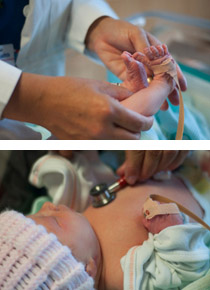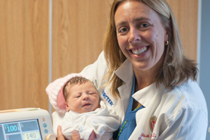Each year in the United States, approximately 10,000 babies are born with critical congenital heart defects (CCHDs)—life-threatening anatomic problems that require surgery within the first month of birth.
Fortunately, in nearly all cases, CCHDs are caught during pregnancy or upon neonatal physical examination. But a substantial number of babies still die or have significant health problems because of unrecognized defects.
A Life-Threatening ‘Blind Spot’

In the first few days after birth, many babies with CCHD have no outward signs of a heart problem, such as a murmur, breathing difficulties, or abnormal skin color. Although they seem perfectly healthy, they have abnormally low blood oxygen levels—a phenomenon called the “cyanotic blind spot” —and may become critically ill a few days after going home.
Over the past 10 years, pulse oximetry (POX), a noninvasive, painless test to measure blood oxygen saturation, has emerged as a mechanism to screen for unrecognized CCHDs before a newborn leaves the hospital.
If a newborn fails the POX screen, physicians use an echocardiogram—a highly accurate but more expensive diagnostic test—to determine whether a defect exists and what intervention is needed.
Although echocardiography is the definitive test to assess for CCHD, it isn’t immediately available at the birth hospital for one-fourth of babies born in Wisconsin. For children born at smaller or more rural hospitals, the average travel distance to another facility with echocardiography capabilities is more than 50 miles. (1)
Evaluating Universal Screening in Wisconsin
Department of Pediatrics cardiologist John Hokanson, MD, along with Elizabeth Goetz, MD, MPH, have collaborated on several projects investigating the use of POX screening to detect missed CCHDs. (1-4)
“As with all medical tests, we have to strike a balance between the effort involved to perform the screening, the impact of false positives, and the consequences if the disease being screened for is missed,” Dr. Hokanson said.

In September 2011, Secretary of Health and Human Services Kathleen Sebelius recommended that POX screening for CCHDs be added to the core panel of newborn screenings for heritable disorders —and that the potential public health effects of the screening be measured.
Now, Dr. Hokanson’s team is one of six nationwide that have received a three-year federal grant to implement those recommendations.
In the Wisconsin SHINE (Screening Hearts in Newborns) project, Dr. Hokanson will lead a statewide collaboration of clinicians from the UW School of Medicine and Public Health (SMPH) and the Medical College of Wisconsin, the Wisconsin Department of Health Services (DHS), and the Wisconsin State Laboratory of Hygiene (SLH).
The project’s goals are threefold. First, the team will provide clinical support to health care providers statewide as they implement the screening protocol. All settings in Wisconsin with planned births will be invited to participate: hospitals, birthing centers, and home births attended by licensed midwives. The team will track POX screening results and combine them with the results of subsequent cardiac testing to determine the protocol’s effectiveness.
Additionally, participating hospitals will provide information on the cost of POX screening and subsequent care to assess the screening’s financial impact.

Finally, the team will survey a subset of families—with babies who passed the screening as well as with babies who did not—to determine the effects of the protocol on parents.
“Wisconsin is a demonstrated leader in newborn screening innovations, and the SMPH, DHS, and SLH have a long history of collaborating on those innovations,” Dr. Hokanson said.
“The SHINE project will provide a real-world analysis of the impact of POX screening in Wisconsin,” he added. “Clinicians and public health policy experts alike will be able to use this information to determine the best way to screen newborns for CCHDs.”
“Wisconsin Critical Congenital Heart Disease Screening Demonstration Program,” is funded by the US Department of Health & Human Services Health Resources and Services Administration (DHHS-HRSA)
- Beissel DJ, Goetz EM, Hokanson JS. Pulse oximetry screening for congenital heart disease in Wisconsin. Congenit Heart Dis. 2011;6(5):521-522.
- Boelke KL, Goetz EM, Hokanson JS. Do blood pressure measurements improve the process? Presented at the 2011 Midwest Society for Pediatric Research.
- Ng B, Hokanson J. Missed congenital heart disease in neonates. Congenit Heart Dis. 2010;5(3):292-296.
- Hokanson, JS, Babcock SO, Goetz EM, Carlton DP. Pulse oximetry screening for congenital heart diseases. Congenit Heart Dis; 2008:3(5).